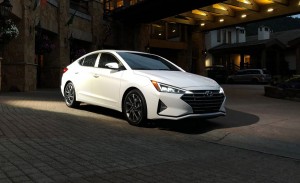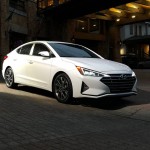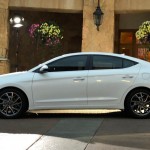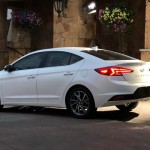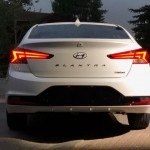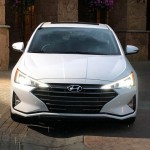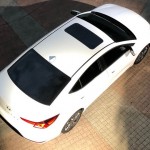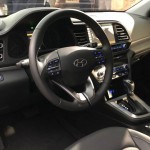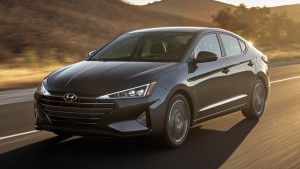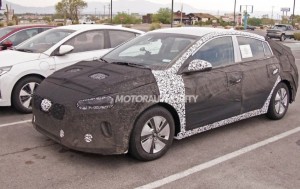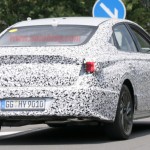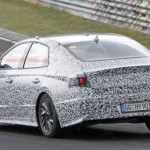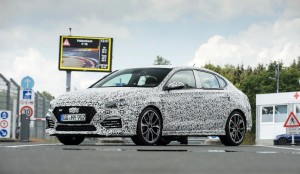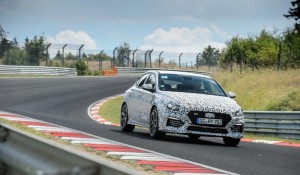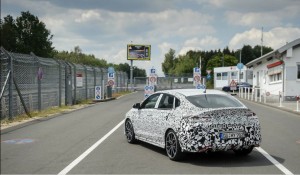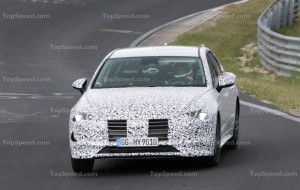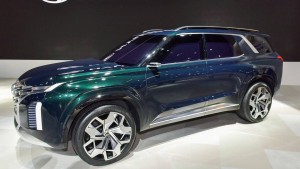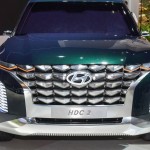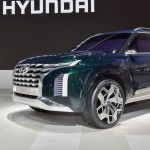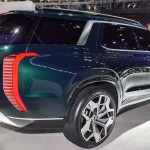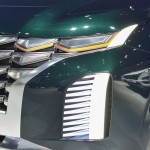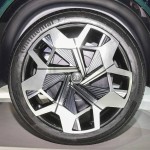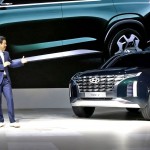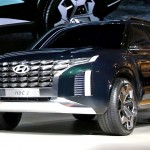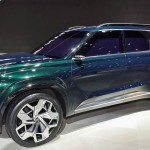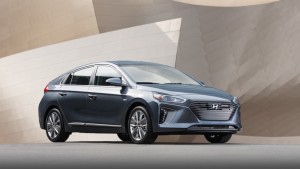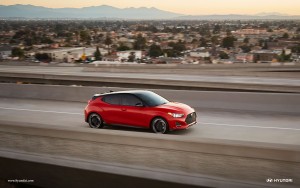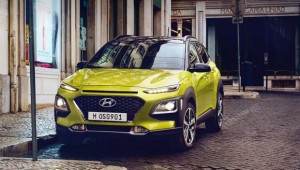Tag Archives: hyundai
2019 Hyundai Elantra Selling For $17,985
Korean automaker Hyundai just released its pricing for the 2019 Hyundai Elantra, which made its global debut in Utah last month. The new car’s base model, the SE trim, will have a starting price tag of $17,985, a mere $150 more than last year’s model.
The Elantra SEL trim, which sits above the base model, now includes a suite of SmartSense safety and convenience technologies. This will come standard from the SEL trim and up. The tech suite includes forward collision-avoidance assist, lane keep assist, and driver attention warning.
But that additional tech means a small surge on the prices, too, though still not much to get your eyes out of your socket. The 2019 SEL trim will start at $20,285, up $550 from last year. The livelier Sport model will set you back $23,285 for a six-speed manual version or $24,385 for one with the seven-speed dual-clutch automatic.
The prices show an increase of around $600 across the range. The Value trim level returns again for the 2019 model year. This time, it will sell for $21,285 or $550 more than the current generation’s price. The Eco trim’s base price is now $21,835 and the top-of-the-line Limited gets a $23,485 price tag, up by $500 from last year.
The increase in prices is due to the fact that the 2019 Elantra compact sedan is getting some cool new features such as a new hood, front fenders, and a new set of headlights that emphasize a redesigned grille. At the back, there’s a new rear fascia and taillights that is angled towards the new trunk lid.
A refined exterior and interior space are the focus of the 2019 edition of the compact sedan. Hyundai particularly wants the Elantra to maintain its design character but have a set of new desirable features that come with an affordable price tag.
Since it was launched in 1991, Hyundai has sold more than three million Elantras. The sedan, now on its sixth generation, is available in six trim levels—SE, SEL, Value Edition, Limited, Eco, and Sport.
Depending on the trim level, there will be three engine options: a 2.0-liter four-cylinder engine with 147 horsepower, a 1.4-liter turbo-four with 128 horsepower, and a 1.6-liter turbo with an estimated 201 horsepower.
All models below the Sport trim will get a six-speed automatic transmission, except for the Eco trim which will be paired with a seven-speed EcoShift dual-clutch. If you want the feel of a manual transmission, you can opt for the Sport model or the six-speed manual option available for the SE trim.
2019 Hyundai Elantra Gets New Angular Face
The 2019 Hyundai Elantra is getting a radical facelift that gives the compact sedan a more angular look than before. Gone is the rounded front fascia of the current model and in its place is a fascia with lots of sharp corners. Even the headlights and the fog lights change to triangle-shaped units and the grille is also sharper.
The headlights intersect with the grille so this makes for an interesting new design. The base of the headlights match up with the top-most slat in the grille and the lights intersect with some of the grille’s top corners. The two new creases on the hood are also leveled up with the vertical slats in the grille.
The car’s rear is also updated. The taillights, like the headlights, have sharpened corners. The housing of the license plate is moved to the bumper from the trunk lid. The large Elantra lettering stretches across the lid of the bumper. This design is similar to the Sonata midsize sedan.
The changes are attractive but the angular lines don’t specifically fit the sides. Meanwhile, the overall silhouette of the car retains the soft and organic lines of the current model.
The safety features of the car are improved. The 2019 Hyundai Elantra gets a camera-based forward collision prevention, lane-keeping assist, and driver attention alert as standard equipment on the second-lowest SEL trim and above.
On the other hand, all trim levels come with a five-inch touchscreen as standard along with a rear-view camera and dynamic guidelines on the screen.
The base SE model is paired with a manual transmission but equipped with Bluetooth and steering wheel controls. The Limited trim, the top end of the model, has an additional eight-speaker sound system with subwoofer, Qi wireless phone charging, and Safe Exit Assist, which warns drivers of approaching cars when the door is open.
Under the hood, we find the same naturally aspirated 2.0-liter four-cylinder that produces 147 horsepower. There’s also the 1.4-liter engine that makes 128 horsepower. The Elantra Sport churns out 201 horsepower, but Hyundai said they will have a restyled version later this year.
2020 Hyundai Ioniq Spy Shots Show New Grille, Design Language
A prototype for the updated version of the Hyundai Ioniq has been spotted testing its hot weather capabilities in California’s Death Valley. This confirms reports that Hyundai is updating its Ioniq family of hybrid and electric cars.
The Ioniq was first introduced in 2017 so this updated version should come to us next year as a 2020 model bearing a slew of midcycle facelifts for Toyota Prius’ competitor.
Based on the spy photos, the Ioniq will receive some major updates for the exterior. The car was heavily camouflaged but not thoroughly enough that we’re able to make out the car’s new mesh pattern for the grille (instead of the current horizontal slats on the current model). The internals of the lights is also new.
The prototype the spy photographers took was either the Ioniq Plug-in Hybrid or the Ioniq Hybrid, though most of the changes should be applied across the range.
We expect that the car’s design will be tweaked to feature elements found on Hyundai’s Le Fil Rouge concept, which was unveiled at this year’s Geneva auto show in March. The concept was focused on Hyundai’s new “sensuous sportiness” design language. The elements of this concept are scheduled to first appear in a production model through the redesigned Sonata next year.
Hyundai hasn’t been clear about changes to its drivetrains, but there should be major updates considering the developments we’ve had in the electrification technology. The Ioniq Hybrid and the Ioniq Plug-in Hybrid are closely related since they both feature a 1.6-liter inline-4 as their internal combustion. They also share a single electric motor paired with a six-speed dual-clutch transmission. That combination can make 139 horsepower and the plug-in hybrid can go 29 miles on electric power alone.
On the other hand, the Ioniq Electric can power up to 120 horsepower from a single electric motor. That alone can cover 124 miles on a single charge of its 28-kilowatt-hour lithium-ion battery.
3 Things We Know So Far About The 2020 Hyundai Sonata
A prototype for the new mid-size 2020 Hyundai Sonata has been spotted while being tested at the Nurburgring track in Germany. It looks like it’s wearing its final skin, though the absence of production taillights and side skirts is noticeable.
1. Based On The Le Fil Rouge Concept Car
At the Geneva auto show last March, the South Korean automaker introduced the Le Fil Rouge Concept Car. The new Hyundai Sonata will borrow key elements and styling from the concept car, including the fastback roof leading to a large duck-tail spoiler. The concept will also be the basis for the sculpting on some of the panels, as well as the short overhangs and multi-slatted grille. Though these elements are in a toned-down form on the new Sonata, they are nonetheless reminiscent of the concept car in March.
2. It Might Carry The Same Powertrain Options
Hyundai hasn’t been very vocal about the mechanical setup of the new Sonata. The current generation offers a 1.6-liter turbocharged inline-4, a 2.0-liter turbocharged inline-4, a 2.4-liter inline-4, and a plug-in hybrid option. There should be more options available for the new model year and the 1.6-liter turbo engine might be dropped from the lineup. The cars should be set up with a front-wheel-drive system.
3. Coming In The Fall Of 2019
The all-new Sonata will be available in dealerships in the fall of 2019 as a 2020 model. That means that the debut should be sometimes in the early months of 2019. Watch out for the i45 name in other markets because that might be the name the Sonata will be using.
The Sonata is in direct competition with the likes of the Chevrolet Malibu, Honda Accord, Nissan Altima, and Toyota Camry. All of these cars have been updated and redesigned in recent years. Competition in this segment is tougher than ever, of course, seeing as most people now prefer crossover SUVs over mid-size sedans.
Check out the new spy shots of the 2020 Hyundai Sonata in the gallery below:
Hyundai Readies Release of i30 Fastback N
Hyundai has been teasing us with the launch of its newest i30 Fastback N for quite some time now. Whether it is the South Korean automaker that’s truly excited about it, we do not know. What we do know is that the model is finally in its final stages of development, and it will soon join the i30 N and the Veloster N when it debuts later this year.
Hyundai took the Fastback testing around different terrains and road surfaces in Europe. Of course, the prime location to test any vehicle is on the Nurburgring Nordschleife, where the company has its own technical center. There, the model is currently undergoing rigid testing and evaluations for performance and durability before it is announced and launched to the public.
The prototype showed that the fastback will have a sloped roofline, a bold rear lip, strong character lines, and the automaker’s signature Cascading grille. Under the hood, it should have the same engine as the i30 N hatch. This means the Fastback would be powered by a 2.0-liter four-cylinder engine that produces 246 horsepower. A Performance package, which we are not sure yet will be offered, can take that output to 271 horses.
The problem is that if you’re living in the United States, you probably won’t see the i30 Fastback N. That makes sense considering Hyundai never brought the i30 N here.
Maybe a petition is in order? Don’t fret. The standard i30 hatch is very similar and probably closely related to the Elantra GT, which we have here. The Fastback body style might be introduced to the US audience through the Elantra lineup. That will happen, of course, if Hyundai North America sees the demand for it.
If it’s any consolation, we are getting the Veloster N, which received positive reviews during its first run.
3 Things We Learned From Seeing The Spy Shots Of 2019 Hyundai i40
Spy shots of the Hyundai i40 were taken and we’ve got the lowdown on what we can expect from the South Korean automaker’s midsized, Europe-facing sedan.
Exterior
When we said there were spy shots, it means that Hyundai did a very thorough job at covering the new i40. The images from TopSpeed show the car wrapped in heavy camouflage, so there’s no way to tell the tiny little details that make the reveals of car exciting. We can see the body style, of course, and we know it’s going to be a sedan with some fastback hints to it. A part of the front grille was revealed, too, featuring thin horizontal bars, though we’re pretty sure these are just placeholders for now.
The headlights gave us a little peek, but it doesn’t look like it’s similar to past models. This could be a completely new set of lights as it doesn’t even resemble the pair we saw on the i40 wagon spotted testing last month.
Interior
We could not see the i40’s interior, but we believe that there won’t be any dramatic changes from the cabin we saw in the i30. We know they came from completely different segments, but there are enough similarities to justify their cabins looking the same.
If there will be a change, it’s going to be the layout since the vertical layout from the latest model is outdated. The i40 should have the same horizontal layout as the i30 with the center console touchscreen located high on the dashboard. The infotainment controls should surround the screen, making it look sleeker and slimmer.
Seating configuration would probably be the same, though we hope that Hyundai fits the i40 with new seats—preferably, something more premium and comfortable than the old one.
Drivetrain
The new i40 won’t be a next-generation model, so it will have the same lineup of engines. It should have quite a number of different engine options. Currently, it offers a 1.6-liter four-cylinder gas engine that produces 133 horsepower, a 2.0-liter four-cylinder that makes either 164 horsepower or 150 horsepower, and a high-spec 2.0-liter gas engine that can churn out 176 horsepower or 162 horsepower.
For the diesel, the i40 should have the same 1.7-liter four-cylinder engine with three different power outputs: 113 horsepower, 137 horsepower, and 139 horsepower.
Is The Grandmaster Hyundai’s New Three-Row Crossover?
Hyundai is finally ready to make its mark in the crossover segment. It is now filling its lineup with the new Kona, as well as updated versions of the Tucson and the Santa Fe. But aside from these models, Hyundai also introduced a possible new three-row crossover at the Busan Auto Show.
Dubbed as the “HDC-2 Grandmaster”, the concept might be a preview to Hyundai’s plan of designing a new three-row crossover. The model should slot right above the Santa Fe and will have seats available for a total for eight passengers.
The design cues of the Grandmaster are based on the Santa Fe, which was previously called the Santa Fe Sport. But don’t think that this new model would be very similar to the smaller Santa Fe. The Grandmaster will have newly designed wheels, taillights, and side windows never before seen in another Hyundai model.
The name of this new model, if the Grandmaster name will stick, is quite cool and it comes the game of chess, wherein the winner is called the grandmaster. In a statement, the South Korean automaker said that the name is indicative of the company’s plan to create a uniform vehicle line-up that would demonstrate the Hyundai look without necessarily being too similar with each other. Each model, though following a specific design cue, should still have a distinctive character and role.
From what we understand, Hyundai is planning to overhaul the design direction of the company’s fleet. The new design will affect more than just one Hyundai model. Along with the Le Fil Rouge concept car, the new Grandmaster will feature the “Sensuous Sportiness” that Hyundai wants to highlight as its new design theme. This will apply on the automaker’s future sedans and SUVs.
The Grandmaster should be available in the market by 2019.
2019 Hyundai Ioniq Gets New Safety, Infotainment Tech
There will be new safety and infotainment technology for the new lineup of the 2019 Hyundai Ioniq. There will be more voice-recognition features and standard remote charge management for electric and plug-in hybrid models.
The models will get navigation capabilities, including an enhanced, natural-language, server-based voice recognition with a new search database that can detect the locations of charging stations. Some of the new available features are driver attention alert, high-beam assist, and automatic emergency braking with pedestrian detection. These are standard for the SEL trim, which also included lane-keep assist and adaptive cruise control.
To be able to make all of these promises come true, Hyundai had to partner with ChargePoint, which operates more than 32,000 charging locations. What they’ll do is provide Ioniq owners access cards and the ability to locate charging stations through the MyHyundai/Blue Link mobile app. The Ioniq electric and PHEV models will come with Blue Link, Google, and Alexa, which will enable the drivers to monitor the charging schedules even when they are not in the car. The tech would also notify the drivers of possible savings they can get during off-peak hours when electricity prices are down.
There are three variants of the Ioniq—the Hybrid, the Electric, and the Plug-In Hybrid.
The Hybrid has a 58 mpg rating from the 1.6-liter direct-injected engine, 32-kilowatt electric motor and 1.56 kWh lithium-ion polymer battery. The Electric variant has 136 mpge rating and can go 124 miles from one charge. The power comes from its 28.0 kWh lithium-ion polymer battery. The Plug-In Hybrid, on the other hand, offers 29 miles of uninterrupted driving for electric power. It uses a 1.6-liter direct-injected Atkinson-cycle four-cylinder mated to a six-speed dual-clutch transmission, a 44.5 kW electric motor, and 8.9 kWh battery.
Pricing hasn’t been announced yet for the 2019 model, though it will be available starting this summer.
Three-Door 2019 Hyundai Veloster Starts At $19,385
It’s the only car right now with three doors—one door on the driver’s side and two doors on the other side. The weird and yet familiar design of the Hyundai Veloster skipped the 2018 model year, but would be back this 2019 with a few upgrades.
Base Veloster
The base Veloster will be coming with a naturally aspirated 2.0-liter inline-four that can produce 147 horsepower and 132 pound-feet of torque. Paired with a six-speed manual transmission and featuring a direct injection, it will be more powerful than the previous 1.6-liter four. Standard safety equipment are forward-collision warning with automated emergency braking, lane-keeping assist, and a driver-attention monitor.
Other tech goods include LED running lamps and a rear spoiler. Seventeen-inch alloy wheels, a 7.0-inch touchscreen, a six-speaker stereo, Apple CarPlay, Android Auto, a six-way manual driver’s seat, and a real metal key.
2.0 Premium
With the same engine but with six-speed automatic and paddle shifters, the 2.0 Premium has a price tag of $23,635. That price will also get you 18-inch wheels on 225-width tires, blind-spot warning with rear cross-traffic alert, a panoramic sunroof, automatic climate control, heated front seats with leatherette inserts, keyless entry with push-button start, an 8.0-inch touchscreen with SiriusXM satellite radio (which is no longer standard on base Velosters), an eight-speaker Infinity stereo, and wireless device charging. You can also enjoy three years of Blue Link telematics services.
Turbo R-Spec
For $23,785, the Veloster will come with a turbocharged 1.6-liter that produces 201 horsepower and 195 pound-feet of torque. The six-speed manual is standard and upgrades will include thicker front and rear anti-roll bars, Michelin Pilot Sport 4 summer tires, LED taillights, LED low-beams with automatic high-beams, a black grille, adjustable rather than fixed rear headrests, specific cloth trim, and Active Engine Sound. The Turbo R-spec will not carry the 2.0 Premium’s blind-spot warning, panoramic sunroof, automatic climate control, and heated front seats.
The Turbo R-spec, however, can get the 2.0 Premium’s features plus the side-mirror turn signals and seven-speed dual-clutch automatic for $2,500 more.
Turbo Ultimate
The loaded Turbo Ultimate will be sold $27,535 for the manual and $29,035 for the automatic. Standard equipment would be the rain-sensing wipers, pedestrian detection, leather with contrast stitching, a dashtop head-up display, navigation, and HD radio. The automatic version will come with adaptive cruise control and the manual will have the summer Michelins.
Hyundai Kona N Crossover With 247HP Is Looking For Approval
Hyundai’s N Performance sub-brand is awaiting approval from the top tier of the South Korean automaker to make over the Kona, the brand’s new compact crossover. Once it has the approval, the Hyundai Kona N Crossover will get 247 horsepower from a 2.0-liter turbo engine used in the i30 N.
Albert Biermann, Hyundai’s N performance boss, already instructed his engineers to develop a test mule version of the Kona. This test mule version would be the consideration for the production of the Kona by the end of the decade. Biermann had no assurances about the Kona getting approval, but he reiterated that the Kona needs to use the powertrain in the i30 N.
To differentiate it from the standard version, the Hyundai engineers would need to develop a different suspension and steering specs for the performance version.
The i30 N is based on the i30, an overseas version of the Elantra GT seeing as the i30 N was never offered to the American market. It was offered in three body styles—a hatchback, a wagon, and a fastback sedan. Fitted with a six-speed manual transmission, the i30 N has two engine options: the 2.0-liter four-cylinder and another version producing 271 horsepower. The latter version will power the Veloster N, which will be available in the US.
The Kona’s standard version will have two engines: a 2.0-liter four-cylinder that produces 147 horsepower and 132 pound-feet of torque, or a 1.6-liter turbocharged engine that can do 175 horsepower and 195 pound-feet of torque.
Other features of the N version of the Kona could possibly be a large grille, red-trimmed undercarriage, a special badge, and interior trim and suspension upgrades that will include a rear diffuser, small roof spoiler, and exposed rear tailpipes.
Since going on sale last February, the Kona had already sold 5,874 units. It also has plans to develop an all-electric version for 2019 and an entry-level Kona Electric will be available in Europe.

